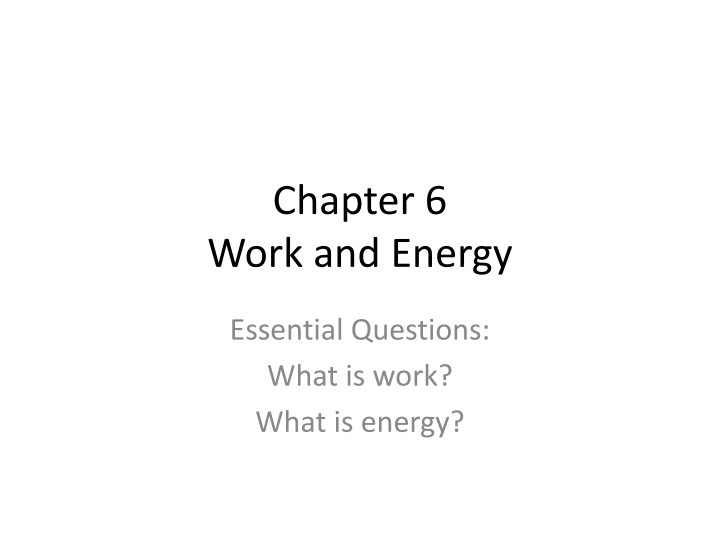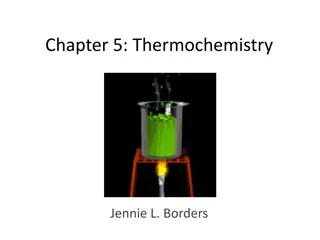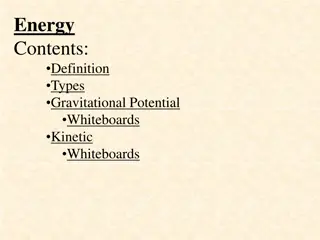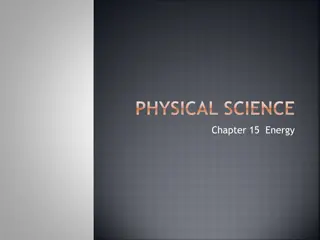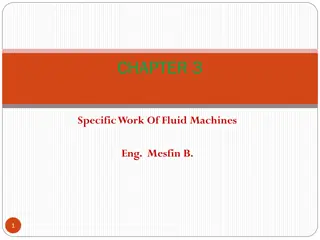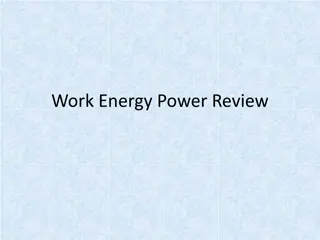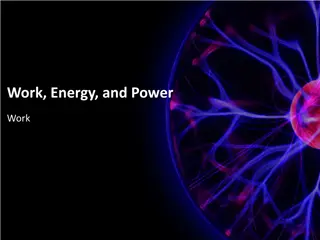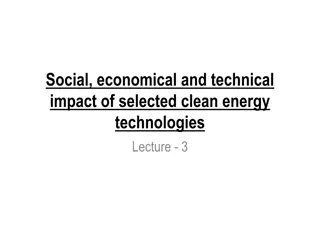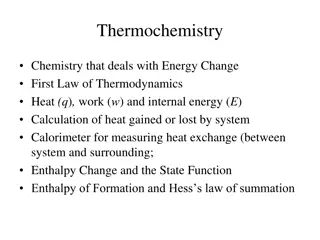Chapter 6: Work and Energy Essentials
Unveil the fundamental concepts of work and energy through exploring questions like what is work, what is energy, and how to compute work. Delve into the key ingredients of work, the definition of work, and engage in hands-on activities to grasp the principles of work and energy effectively.
Download Presentation

Please find below an Image/Link to download the presentation.
The content on the website is provided AS IS for your information and personal use only. It may not be sold, licensed, or shared on other websites without obtaining consent from the author.If you encounter any issues during the download, it is possible that the publisher has removed the file from their server.
You are allowed to download the files provided on this website for personal or commercial use, subject to the condition that they are used lawfully. All files are the property of their respective owners.
The content on the website is provided AS IS for your information and personal use only. It may not be sold, licensed, or shared on other websites without obtaining consent from the author.
E N D
Presentation Transcript
Chapter 6 Work and Energy Essential Questions: What is work? What is energy?
Where must we start? For something to happen (pendulum to swing, coaster to roll, etc.), we must start with .
Work When a force acts upon an object to cause a displacement of the object, it is said that work was done upon the object. There are three key ingredients to work - force, displacement, and cause. In order for a force to qualify as having done work on an object, there must be a displacement and the force must cause the displacement. PCR http://www.physicsclassroom.com/Class/energy/ u5l1a.cfm
Lab: How do you compute Work? The amount of work can be determined by what the worker (you in this case) gets done, or by mathematically combining force and displacement. You will get done the same thing in each trial. However, you will do it with varying forces each trial, over varying displacements. Your goal is to determine how to mathematically displacement to compute determine possible units for work. combine force and Also work.
Who does more work? Who pushed harder? farther?
Inclined Plane Activity 1. Tilt the ramp against a support. 2. Determine the displacement needed (length of ramp) to raise the lab cart exactly 1.00m vertically. 3. Measure the force needed to drag the cart up the incline at a constant speed. Be sure to pull scale parallel to the track! 4. Repeat at three other angles for the track. Try to use as large a range of angles as possible. Perform one more control trial. 5. Compute the product of the force and displacement for each of the trials. 6. Record results neatly in a table on WB.
Work W = (F)( r) cos Units: joule (J) one J = 1.0N x 1.0m 3.6 million joules equals 1 kWhr 4.19 J = 1 calorie Work is a scalar quantity, but can be + or - Work is defined as: 1. The process where a force acts through a displacement to transfer energy from one object (or one form) to another. 2. The use of energy to accomplish something.
Examples PCR W&E Lesson 1b (Calculating the amount of work done) CYU #1, 2, 5
Start QUEST Complete to #14 on the Work, Energy, Power Quest by tomorrow!
Work Review: What is the SI unit for work? What formula is used to compute work? A parent pushes horizontally with a force of 30.0N onto a 5.00kg stroller carrying a 10.0kg baby, keeping the stroller moving 20.0m up a 5.00 incline at a constant speed of 1.5m/s. How much work does the parent do?
What is needed to do work? ENERGY
Energy is The ability to do WORK
Mechanical Energy is either: Potential (gravitational or elastic) or Kinetic
On what does (gravitational) Potential Energy depend?
James Prescott Joules Experiment Calorimeter used by Joule in his 1876 determination of the mechanical equivalent of heat. Image result for Calorimeter used by Joule to determination of the mechanical equivalent of heat
Gravitational Potential Energy (PEg) PEg= mgh OR mgy any height may be set as the vertical origin, but this should not change throughout a problem. If the origin is moved, the problem is re-started Units: joule (J) one J = 1.0N x 1.0m PEgis a scalar quantity, but can be + or - Gravitational Potential Energy is defined as: The ability an object has to do work due to its weight and vertical position. The gravitational potential energy an object has at one height (relative to another height) is equal to the work done to move the object to that height.
Elastic Potential Energy PEs= k( l)2 (we are NOT doing this)
Example Pat (60kg) must walk from the 1stfloor of South to the 3rd floor. Each floor is separated by 4.73m. How much more gravitational potential energy does Pat have: a) on the second floor than on the first floor? b) on the third floor than on the second floor? c) on the third floor than on the first floor? Pat did work by climbing the stairs equal to the change of potential energy.
Work causes a change of ENERGY Work done by a NET FORCE causes a change of ____________
Work causes a change of energy Work done by a NET FORCE causes a change of SPEED and therefore a change of_____________ ____________
Work causes a change of energy Work done by a NET FORCE causes a change of SPEED and therefore a change of KINETIC ENERGY
Lab: What is the mathematical relationship between the final speed (m/s) of a system and the net work (J) done on it (if it started from rest)?
What is the mathematical relationship between the final speed (m/s) of a system and the net work (J) done on it (if it started from rest)? Release the cart, allowing it to accelerate along the track. Using the position vs time and velocity vs time graphs, determine the velocity and position of the cart at the same time. Repeat for at least four more times. Measure the average (mean) net force during the acceleration. Compute the work done by the net force through the change of position. Graph _________(__) vs ____________(__) Prepare for PLQ
Wnet= KE Derivation Conclusion: Final speed is proportional to the square root of the net work done (if you start at rest. This means, to double your final speed, four times as much net work must be done.
Kinetic Energy KE = mv2 Units: joule (J) one J = 1.0N x 1.0m KE is a scalar quantity and can only ever be positive Kinetic Energy is defined as: The energy a mass has due to its motion. The kinetic energy an object has is equal to the NET work done to put it in motion, from a state of rest.
Kinetic Energy Example A 1200kg car accelerates from rest to 10.0m/s in 2.0 seconds. How much kinetic energy does it gain? If the same car now accelerates from 10.0m/s to 20.0m/s in 6.0 seconds, how much kinetic energy does it gain?
Continue QUEST assignment up through #31
Power is the rate at which
Power is the rate at which work is done or the rate at which energy is transferred P= W/ t or P = E/ t
Power is But, Since: P=W/ t P= (F . x)/ t Then P= F .vavg
Assignment: CYU Lesson 1 d & f
